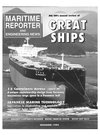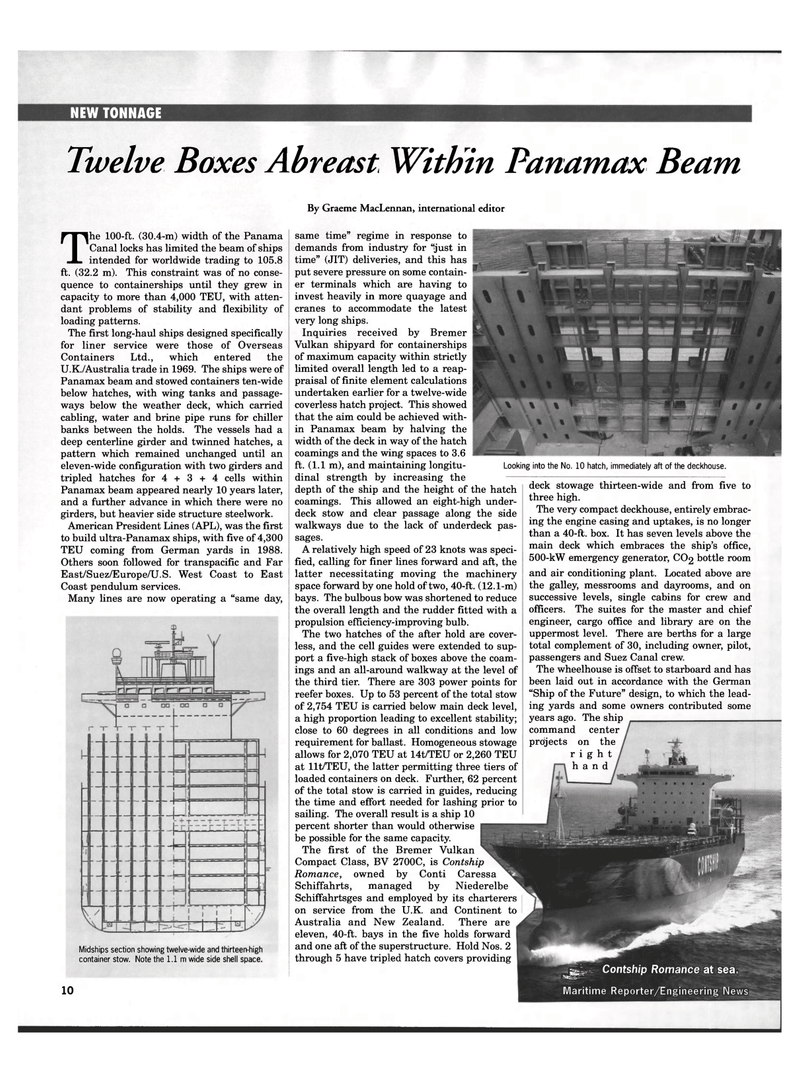
Page 8: of Maritime Reporter Magazine (December 1996)
Read this page in Pdf, Flash or Html5 edition of December 1996 Maritime Reporter Magazine
NEW TONNAGE
Twelve Boxes Abreast Within Panamax Beam
By Graeme MacLennan, international editor
The 100-ft. (30.4-m) width of the Panama Canal locks has limited the beam of ships intended for worldwide trading to 105.8 ft. (32.2 m). This constraint was of no conse- quence to containerships until they grew in capacity to more than 4,000 TEU, with atten- dant problems of stability and flexibility of loading patterns.
The first long-haul ships designed specifically for liner service were those of Overseas
Containers Ltd., which entered the
U.K./Australia trade in 1969. The ships were of
Panamax beam and stowed containers ten-wide below hatches, with wing tanks and passage- ways below the weather deck, which carried cabling, water and brine pipe runs for chiller banks between the holds. The vessels had a deep centerline girder and twinned hatches, a pattern which remained unchanged until an eleven-wide configuration with two girders and tripled hatches for 4 + 3 + 4 cells within
Panamax beam appeared nearly 10 years later, and a further advance in which there were no girders, but heavier side structure steelwork.
American President Lines (APL), was the first to build ultra-Panamax ships, with five of 4,300
TEU coming from German yards in 1988.
Others soon followed for transpacific and Far
East/Suez/Europe/U.S. West Coast to East
Coast pendulum services.
Many lines are now operating a "same day,
Midships section showing twelve-wide and thirteen-high container stow. Note the 1.1 m wide side shell space. 10 same time" regime in response to demands from industry for "just in time" (JIT) deliveries, and this has put severe pressure on some contain- er terminals which are having to invest heavily in more quayage and cranes to accommodate the latest very long ships.
Inquiries received by Bremer
Vulkan shipyard for containerships of maximum capacity within strictly limited overall length led to a reap- praisal of finite element calculations undertaken earlier for a twelve-wide coverless hatch project. This showed that the aim could be achieved with- in Panamax beam by halving the width of the deck in way of the hatch coamings and the wing spaces to 3.6 ft. (1.1 m), and maintaining longitu- dinal strength by increasing the depth of the ship and the height of the hatch coamings. This allowed an eight-high under- deck stow and clear passage along the side walkways due to the lack of underdeck pas- sages.
A relatively high speed of 23 knots was speci- fied, calling for finer lines forward and aft, the latter necessitating moving the machinery space forward by one hold of two, 40-ft. (12.1-m) bays. The bulbous bow was shortened to reduce the overall length and the rudder fitted with a propulsion efficiency-improving bulb.
The two hatches of the after hold are cover- less, and the cell guides were extended to sup- port a five-high stack of boxes above the coam- ings and an all-around walkway at the level of the third tier. There are 303 power points for reefer boxes. Up to 53 percent of the total stow of 2,754 TEU is carried below main deck level, a high proportion leading to excellent stability; close to 60 degrees in all conditions and low requirement for ballast. Homogeneous stowage allows for 2,070 TEU at 14t/TEU or 2,260 TEU at llt/TEU, the latter permitting three tiers of loaded containers on deck. Further, 62 percent of the total stow is carried in guides, reducing the time and effort needed for lashing prior to sailing. The overall result is a ship 10 percent shorter than would otherwise be possible for the same capacity.
The first of the Bremer Vulkan
Compact Class, BV 2700C, is Contship
Romance, owned by Conti Caressa
Schiffahrts, managed by Niederelbe
Schiffahrtsges and employed by its charterers on service from the U.K. and Continent to
Australia and New Zealand. There are eleven, 40-ft. bays in the five holds forward and one aft of the superstructure. Hold Nos. 2 through 5 have tripled hatch covers providing
Looking into the No. 10 hatch, immediately aft of the deckhouse. deck stowage thirteen-wide and from five to three high.
The very compact deckhouse, entirely embrac- ing the engine casing and uptakes, is no longer than a 40-ft. box. It has seven levels above the main deck which embraces the ship's office, 500-kW emergency generator, CO2 bottle room and air conditioning plant. Located above are the galley, messrooms and dayrooms, and on successive levels, single cabins for crew and officers. The suites for the master and chief engineer, cargo office and library are on the uppermost level. There are berths for a large total complement of 30, including owner, pilot, passengers and Suez Canal crew.
The wheelhouse is offset to starboard and has been laid out in accordance with the German "Ship of the Future" design, to which the lead- ing yards and some owners contributed some years ago. The ship command center projects on the right hand & Contship Romance at sea. Sifgaas*;;;-" . -.A.. ,1..
Maritime Reporter/Engineering News

 7
7

 9
9
